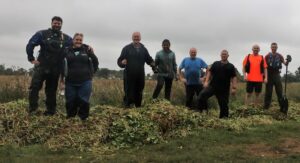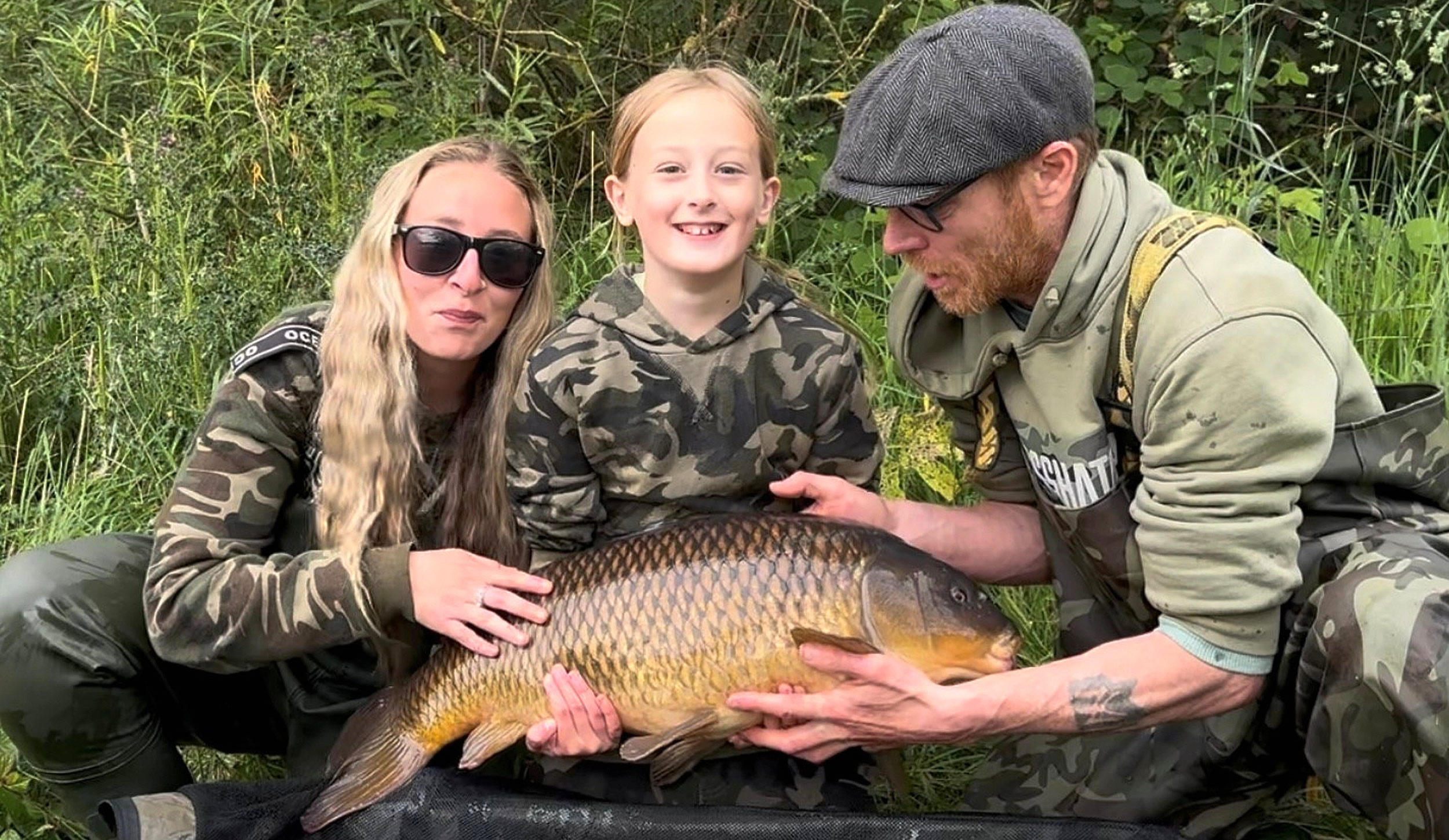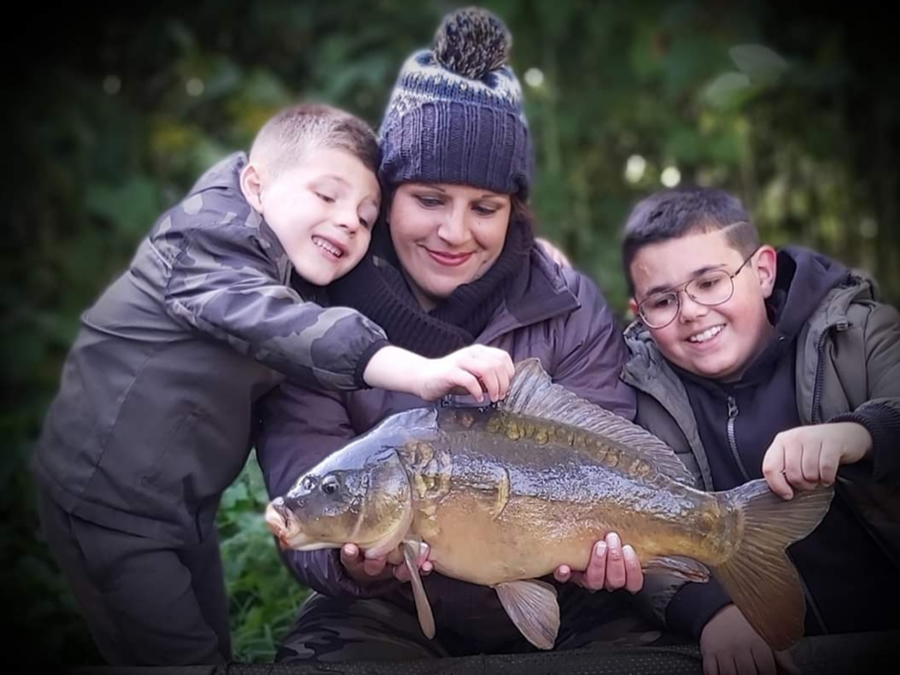
News
Anglers unite to control highly invasive floating pennywort on the River Wey
Angling clubs have joined forces with environmental groups on the River Wey to help control the invasive non-native plant, floating pennywort. This is the first time that multiple organisations have come together to run a joint event.
Working in partnership facilitates more strategic management of invasive species, helping to halt their further spread and minimise their impact on wildlife, recreational activity and human health.
Invasive non-native species present one of the greatest threats to biodiversity, including fish populations, and their impact continues to grow. They are species that have been introduced by humans outside of their native range and result in significant negative impacts where they are introduced.
Floating pennywort is one of these invasive species and was first found in the wild in England in the 1990s. This freshwater plant can grow at a remarkable 20 cms a day resulting in dense mats on the water’s surface. These thick, multi-layering mats block out light, smothering native plants and removing important habitat for fish and insects. These mats also inhibit recreational activity, inhibiting access to anglers and other water users and can present a flood risk when the mats build up around weirs and drains.
Floating pennywort can spread and grow from tiny fragments, as small as a 10p piece, and can last an incredible 14 days out of water. Small plant fragments could be spread accidentally between waters on damp equipment, boats and clothing leading to their introduction into new waters. It also makes management difficult, with repeated action needed to effectively tackle established mats.
On the River Wey, coordinated action has begun to do just that. The Angling Trust and angling clubs along the Wey have joined forces with other stakeholders to work collaboratively to manage floating pennywort. This includes British Canoeing, paddling groups, National Trust, the Environment Agency and Thames Water.
Working together, the group plan to start management at Papercourt Lock, near Woking, the furthest point the plant is established upstream. Through coordinated action, the aim is to gradually work their way downstream, removing mats from the river and restoring watercourses and recreational spaces impacted by the invasion.
This project on the Wey represents just one of a series of partnerships that are being developed across the country. As well as the benefit to the environment, it presents a fantastic opportunity for people to get out and spend some time in their local environment and meet people from their local community.
Anyone interested in finding out more or want advice on how to set up their own group please visit the GB NNSS website Floating Pennywort Strategy page.


Trevor Renals, Invasive Species Technical Lead, Environment Agency said:
“Floating pennywort is a highly-damaging non-native weed, which impacts the flora and fauna of our rivers and our ability to enjoy recreation such as angling and paddling. It also presents a potential flood risk and could obstruct flood defence assets. No single organisation has a duty to manage floating pennywort, so it is only through collaboration that we can control this plant.
“It’s fantastic to see people coming together on the River Wey to tackle this problem. We helped to establish and fund this exciting partnership, and hope other groups across the country will be inspired to get together to fight invasive species.”
Dr Emily Smith, Environment Manager, Angling Trust said:
“It was great to be involved and to see first-hand what can be achieved through coordinated action to tackle invasive species. Anglers often lead the way when it comes to conservation, and it is fantastic to see groups from different backgrounds coming together for a united cause. This work supports the national strategy on floating pennywort and will help to make a real difference in controlling the spread of the species, reducing the damage it causes to fish and angling, and protect these environments that we all enjoy.”
Robin Dix, Woking and District Angling Association said:
“Being able to use various sections of the River Wey and associated streams gives a huge benefit to all who enjoy river fishing. However, floating pennywort encroaches on the amount of water we have to use, this is so difficult to manage as removal can just start new growth due to the nature of the weed.
“WDAA have been working with the EA and now the Angling Trust, on ‘safe’ removal of this plant. We had a tremendous turnout at Papercourt Lock to Walsham Meadows to clear the floating pennywort with 60-plus people ranging from canoeists, paddle boarders, open water swimmers and of course WDAA members. We’ve made a big dent but it will need many more days like this if we are to clear our waters on Abbey, Eel Trap and Pigeon House. If you weren’t there at the weekend then please look out for future dates and get involved. This is our chance to showcase the rivers and make them accessible to all.”
Richard Atkinson, Policy Officer, British Canoeing said:
“We are very excited to be working with the Angling Trust and other organisations including our hosts, the National Trust, to tackle floating pennywort on the River Wey. The outcome of the event will provide real evidence that effective management of floating pennywort can only be achieved through strategic, coordinated action.”
Carol Reeves, Addlestone Canoe Club said:
“What an eye opener on all things pennywort! It became clear that to control this beast that clogs up our waterways, causes flood damage and presents a danger to wildlife and people, education is key. Let’s spread the word and encourage volunteers to assist with the removal and control of floating pennywort.”
You might also like

SENSAS FUTURE NETWORKS DO THE DOUBLE DOUBLE IN YOUTH…

NATIONAL GLORY FOR RAMMY AT LINDHOLME

Three British record fish claims ratified

Making plans for kids and holiday activities? Fun, safe…

Get Fishing Fund – Funded Project: Fishing Opens New…

Climate change fuelling dangerous river pollution across England and…

NEW BLOG: The best thing about fishing – from…

Ethan gets his Gold Get Fishing Award – young…

Summer of Fishing 2025 is here – get into…

Get Fishing Awards were at Bristol Festival of Nature…

VIDEO: It’s not all about the fishing… Check out…

ENGLAND TAKE GOLD IN HOME NATIONS BOAT CHAMPS

SENSAS FUTURE NETWORKS DO THE DOUBLE DOUBLE IN YOUTH…

NATIONAL GLORY FOR RAMMY AT LINDHOLME

Three British record fish claims ratified

Making plans for kids and holiday activities? Fun, safe…

Get Fishing Fund – Funded Project: Fishing Opens New…

Climate change fuelling dangerous river pollution across England and…

NEW BLOG: The best thing about fishing – from…

Ethan gets his Gold Get Fishing Award – young…

Summer of Fishing 2025 is here – get into…

Get Fishing Awards were at Bristol Festival of Nature…

VIDEO: It’s not all about the fishing… Check out…

ENGLAND TAKE GOLD IN HOME NATIONS BOAT CHAMPS

SENSAS FUTURE NETWORKS DO THE DOUBLE DOUBLE IN YOUTH…

NATIONAL GLORY FOR RAMMY AT LINDHOLME

Three British record fish claims ratified

Making plans for kids and holiday activities? Fun, safe…

Get Fishing Fund – Funded Project: Fishing Opens New…

Climate change fuelling dangerous river pollution across England and…

NEW BLOG: The best thing about fishing – from…

Ethan gets his Gold Get Fishing Award – young…

Summer of Fishing 2025 is here – get into…

Get Fishing Awards were at Bristol Festival of Nature…

VIDEO: It’s not all about the fishing… Check out…









